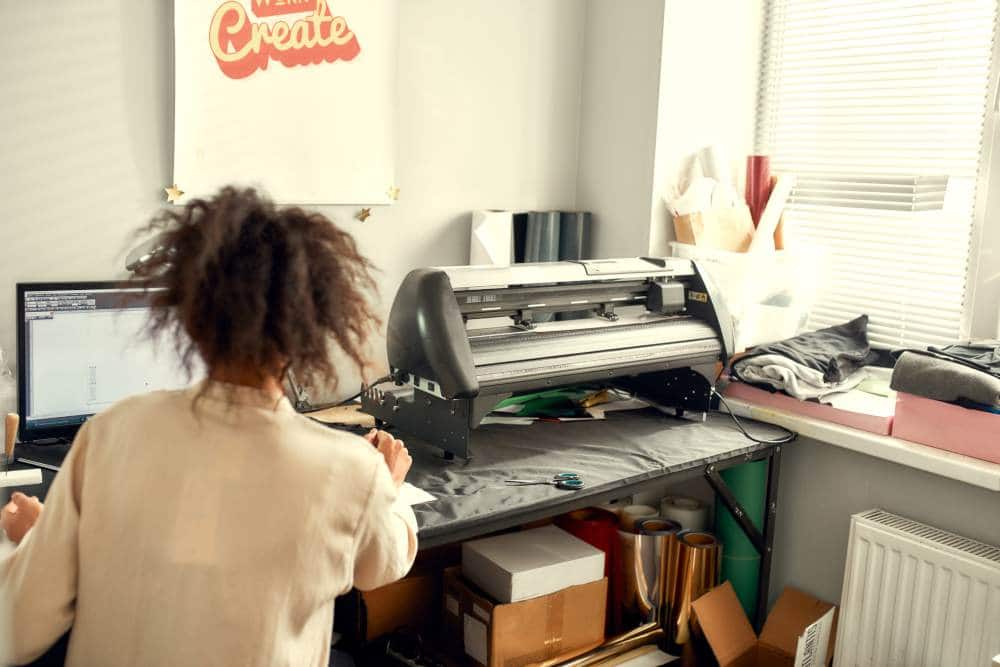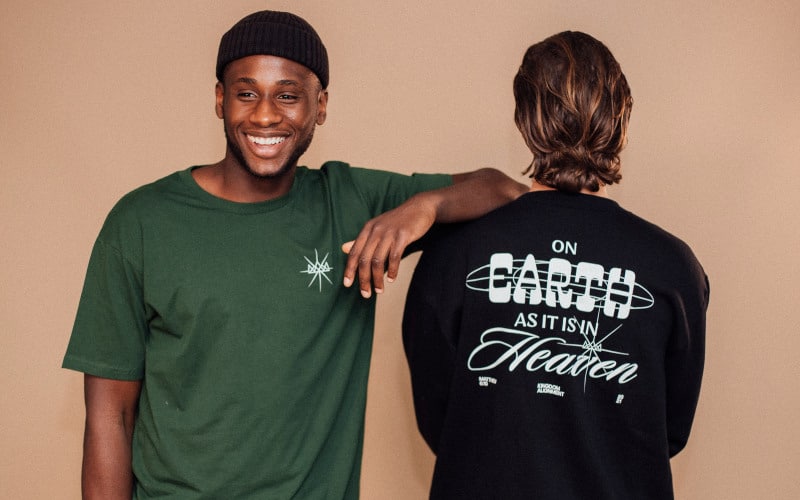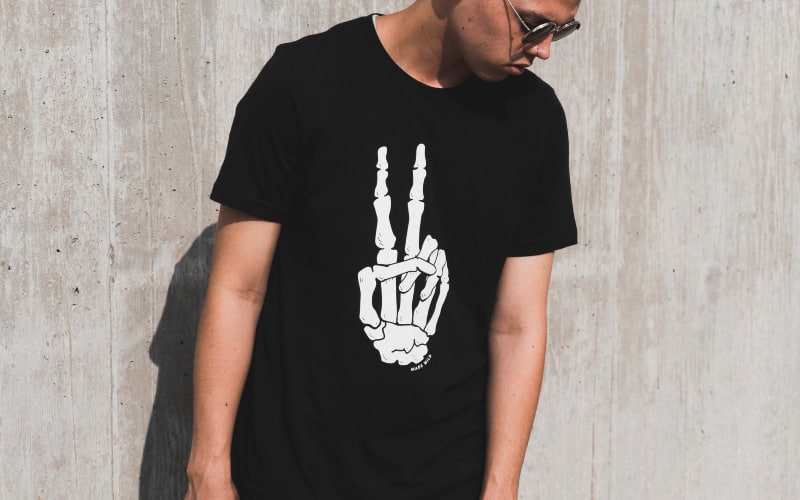When printing t-shirts, the best file format depends on the type of printing. Screen printing, Vinyl transfer printing, and Print-On-Demand printing all have different requirements.
While I’ve worked with DTG and Vinyl printing the most, I’ve also produced many Screen printed t-shirts. Over the years, knowing which file types I need for each printing type has become easy. For DTG or Print on Demand, for example, I’ve always had great success with a 300 DPI, transparent PNG that is the actual width the design will be printed on the t-shirt.
But for other printing types, a PNG won’t work. The purpose of this post is to help you quickly determine what file format is best for your t-shirt printing type.
What is the best file format for Screen printing?

The best file formats for t-shirt screen printing are vector image formats, such as an AI format or a PDF with a vector image. They, unlike bitmap, are scalable with no resolution limitations.
I will go into more detail about vector images in the post.
What is the best file format for Print-on-Demand printing?
The best file format for Print-on-demand printing is transparent PNG, with a resolution between 150 to 300 dpi. You will also want to create the image the same size as it will be printed on your largest t-shirt. If your largest print is 12″ x 15″, then be sure and export a PNG in that size or larger. I always use 300 DPI for the best quality.
What is the best file format for Heat Transfer Vinyl Printing?
The best file format for Heat Transfer vinyl printing is EPS vector files. Vector files allow you to increase and decrease the size of the file depending on the size of the image without losing quality. EPS files are also excellent for “line art” which is perfect for precise cuts you will make with the vinyl cutter.
What’s the Difference Between Vector and Bitmap For T-Shirts?

The two most common image formats used for t-shirt printing are bitmap and vector image formats. Vector image formats take preference over bitmap where possible for several reasons. Likewise, it may occasionally be better to use bitmap image formats for such things as highly detailed illustrations that vectors cannot store.
Bitmap images are made up of pixels. Each pixel contains colors that make up the image. They are great for detailed illustrations and photographs. Unfortunately, if their resolution gets scaled up from their native resolution, they become pixelated or lower quality. Two standard bitmap formats are JPEG and PNG. The best bitmap choice for print-on-demand printing is PNG format. JPEGs are rarely used for printing.
Vector images are produced by mathematical equations and are the best for screen printing and vinyl cutters. They are not affected by native image resolutions. Vector images can get scaled to any image resolution you want to without losing quality. The picture does not lose quality because it is defined by mathematical equations that are not affected by image resolutions, unlike bitmap images. Vector images get commonly stored in PDF and AI formats.
Below, the vector and bitmap image formats are elaborated upon and how they affect t-shirt printing:
Why are Bitmap Image Formats Great for Print-on-Demand T-Shirts?

The grid of pixels in bitmap images can create highly detailed illustrations and photographs which vector images cannot do with their mathematical equations. The pixels are tiny blocks stored in a grid that make up a photograph or detailed illustration. These small blocks of pixels are in great quantity on the grid and contain rich colors of many gradients.
Unfortunately, unlike vector images, bitmap images are dependent on their image resolution. Higher resolution images are a must. A high image resolution means that the image is of fantastic quality. Image resolution is the number of pixels in the grid that makes up the image. If an image is of a low resolution, you would see large pixels hence the term pixelated. Seeing the pixels of an image makes it of low quality.
This works perfectly for Print-on-demand because DTG machines can print in super high quality and resolution.
DPI represents the number of pixels that make up the detailed image or photograph. The ideal image resolution for a Print-on-demand t-shirt should be at least 200 dpi. Unfortunately, this resolution is not infinite. If you attempt to scale the image above said resolution, it would appear pixelated.
On the other hand, an image resolution of 72 DPI would be terrible, even for small-sized shirts. Unfortunately, the higher the resolution, the bigger the image’s file size would be.
For example, say you want to print a detailed photograph of Mount Everest on a t-shirt; the ideal resolution would vary by t-shirt size. For a small-sized t-shirt, a resolution of 150 DPI for the photo of Mount Everest may be acceptable as the shirt is small, just like the resolution. But say you need to print that same photograph on a large-sized t-shirt and scale it to fit it, the image on the t-shirt will appear very pixelated and of low quality.
For the photo of Mount Everest to appear as pristine quality on the large-sized t-shirt, it must be of a very high image resolution. For a large-sized t-shirt, the photograph must be about 300 DPI to appear of excellent quality on the t-shirt. The higher the resolution, the more you can scale the picture without losing quality. But, this is not the only thing to watch out for in bitmap images.
Why Are Vector Image Formats Best for Screen Printing?

A vector image, saved in such image formats as PDF, EPS, or AI, is the best for t-shirt screen printing. Unlike bitmaps, which get made up of pixels that store all the qualities, such as the different colors of pictures, mathematical equations make up those qualities. As a result of mathematical equations defining the data of the points of the images and then filling in the color, they are not affected by image resolution.
A vector image can get scaled to any resolution you want to without losing quality. This quality of vector images makes it perfect for t-shirts of any size. In other words, you will get a clean-looking print on the t-shirt despite the size of the t-shirt, unlike a bitmap where the image may be pixelated if sent to the printer, or print shop, as a low-resolution image.
In addition, a Screen Printing machine cannot print at the resolution that bitmaps like PNGs offer.
The con to vector images is that they are not able to produce the many details as those with a highly detailed illustration or photograph. They are great for simple images containing simple colors and lines such as logos or cartoon-looking coffee mugs but cannot get used for highly detailed realistic photos.
Most images printed on t-shirts are screen printed, and therefore are simple and not extremely detailed. At the end of the day, vector image formats are optimal for screen printing.
Conclusion
Bitmap images, like PNGs, are recommended for print-on-demand printing. Highly detailed photos including photographs or illustrations can be printed on t-shirts using transparent PNG images. PNG images must be of a high resolution, like 200 dpi at least, so the image of the t-shirt can print with minimal quality loss.
Vector images are great for vinyl cutting and screen printing. Vector images are not affected by image resolution. The best image format for a vector image is an AI or PDF, as they are user-friendly and highly accessible, and easy to set up for printing.
Bryan E. Robinson is the former owner of TshirtGrowth. He has sold t-shirts since 2006 through dropshipping, screen printing, vinyl printing, DTG, Print on Demand, and more. Bryan has created his own t-shirt designs through Photoshop, Canva, and other platforms, as well as worked with freelancers to create many of his designs. Besides t-shirts, Bryan has over 18 years of experience in online marketing with eCommerce, B2B SaaS, B2C products, and more.


